Introduction
The giant pangolin (Smutsia gigantea) is a fascinating, scaly mammal. It is the largest of the eight species of pangolin, growing to nearly 6.6 feet (2 metres) long and weighing over 5 stone (30 kg).1https://www.nationalgeographic.com/animals/mammals/facts/giant-pangolin Pangolins are truly unique animals, and rank among the likes of the duck-billed platypus for their peculiar appearance. Covered from head to toe in scales, walking close to the ground on their short legs and claws, it’s easy to mistake the pangolin for some kind of prehistoric reptile.
Of the eight species of pangolin, four species live in Asia and another four in Africa. Uganda is home to three of the four African species: the ground pangolin, giant pangolin and the white bellied pangolin, which is also known as the tree climbing pangolin.2https://oxpeckers.org/2022/05/ugandas-fight-to-stop-pangolin-poaching/ Because pangolins are solitary and most are nocturnal and highly secretive, there is no reliable information about their population size. All we do know is that it is decreasing and the giant pangolin is endangered.3https://www.iucnredlist.org/species/12762/123584478#population
Fascinating facts
The giant is a giant
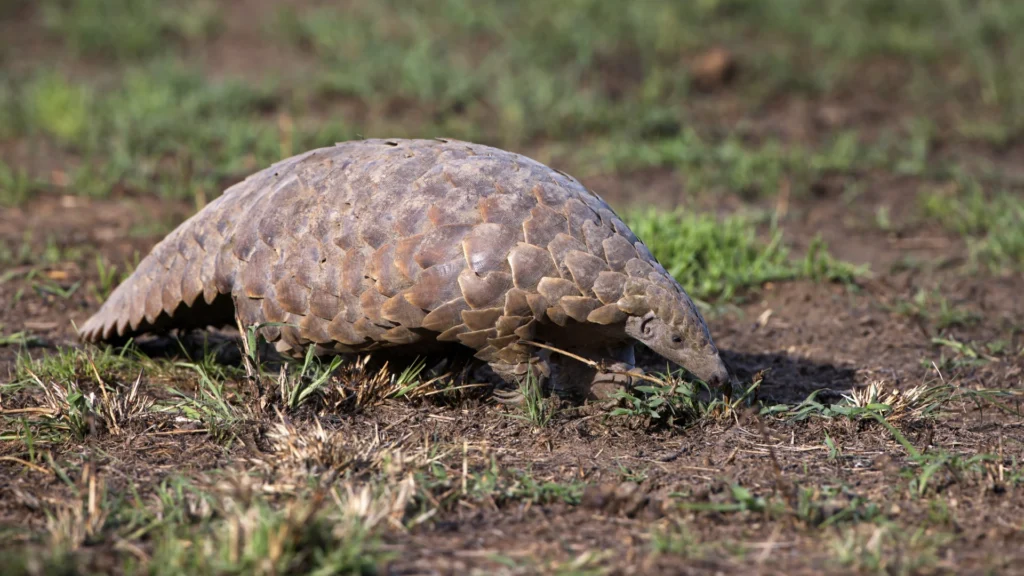
The giant pangolin is the largest living pangolin species, weighing up to 5.5 stone (35 kg).4https://pangolinsg.org/portfolio/giant-pangolin/ Males are larger than females, with males typically 4.3 feet (1.3 m) to 5.9 feet (1.8 m) and females about 3.6 feet (1.1 m) to 4.6 feet (1.4 m).
A pinecone on legs
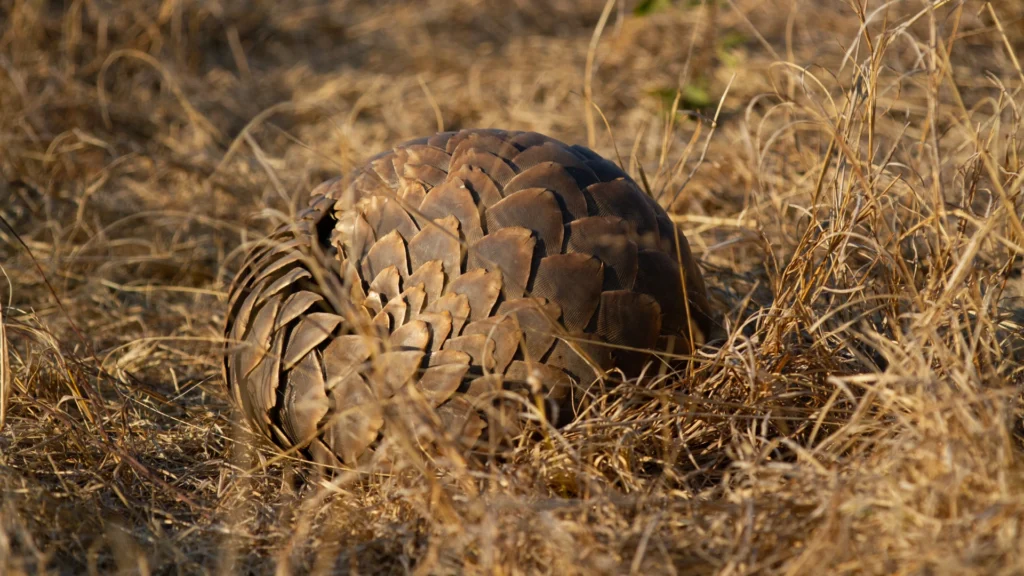
Because of their scales, pangolins have been described as a “walking pinecone”,1https://www.nationalgeographic.com/animals/mammals/facts/giant-pangolin or are often mistaken for a reptile. Like reptile scales, and the horns of rhinos, pangolin scales are made from keratin, the same material that makes our hair and fingernails. A pangolin’s scales are their only defence against predators. When threatened, a pangolin will roll up in a tight ball using their tough and impenetrable scales to protect their soft bellies from the sharp teeth of leopards and hyenas.
Mysterious mammals
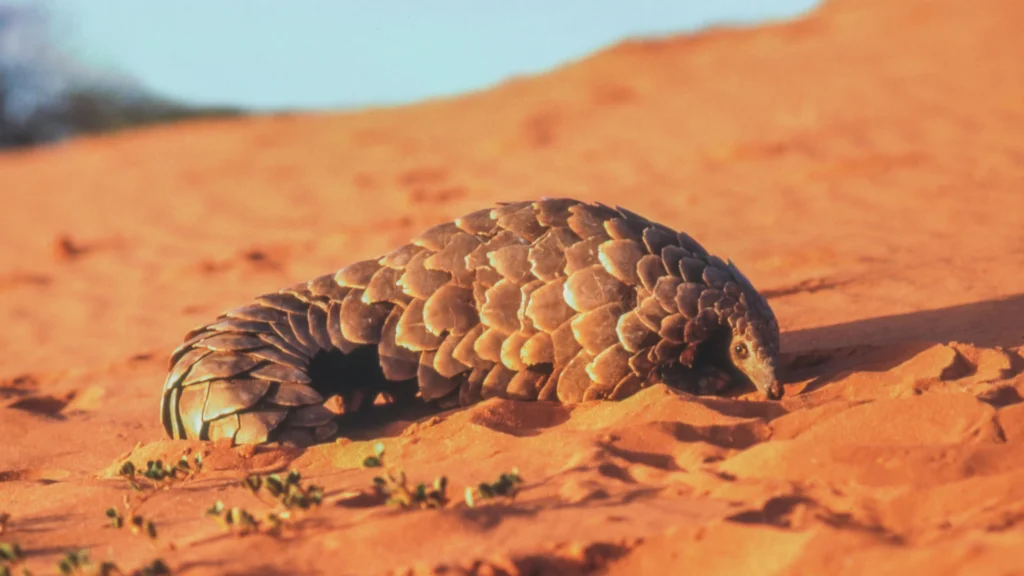
Pangolins are solitary, mostly nocturnal mammals and much of their behaviour still remains a mystery.5https://www.unodc.org/documents/wwcr/2020/Wildlife_crime_Pangolin_UNODC.pdf Nothing is known about the mating habits of giant pangolins, but scientists think they are probably similar to other pangolin species, having one baby every two years.6https://africanpangolin.org/discover/giant-ground-pangolin/ The pangolin cub nurses for three to four months and rides around on their mother’s back and tail.
A sticky situation
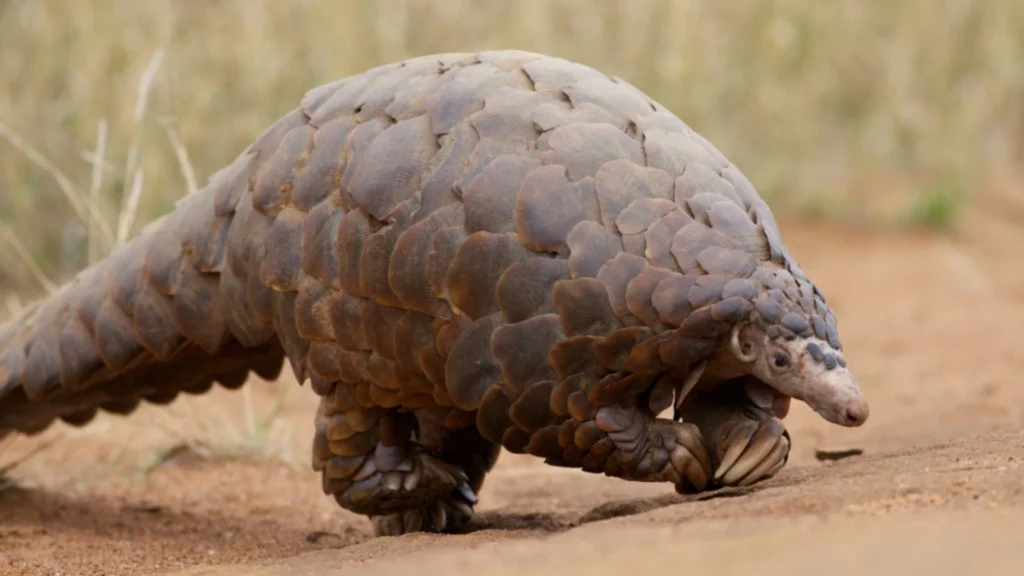
Giant pangolins are insectivores and eat ants and termites. They can detect the insects by smell. Because the giant pangolin is large, they are particularly well-suited to breaking open termite mounds by resting their weight on their tail and putting their body weight on the mound, then ripping into it with their front claws. Giant pangolins don’t have any teeth but they have very long and sticky tongues perfectly evolved for slurping up termites and ants. A giant pangolin’s tongue is about 70 cm long and reaches out of their mouth for about 30cm. In fact, in some other species of pangolin, their tongue can be longer than their body! When they have their head buried in an ants’ nest, they have the very useful ability to close their nostrils to keep ants out.7https://www.awf.org/wildlife-conservation/pangolin
Stinky bottom
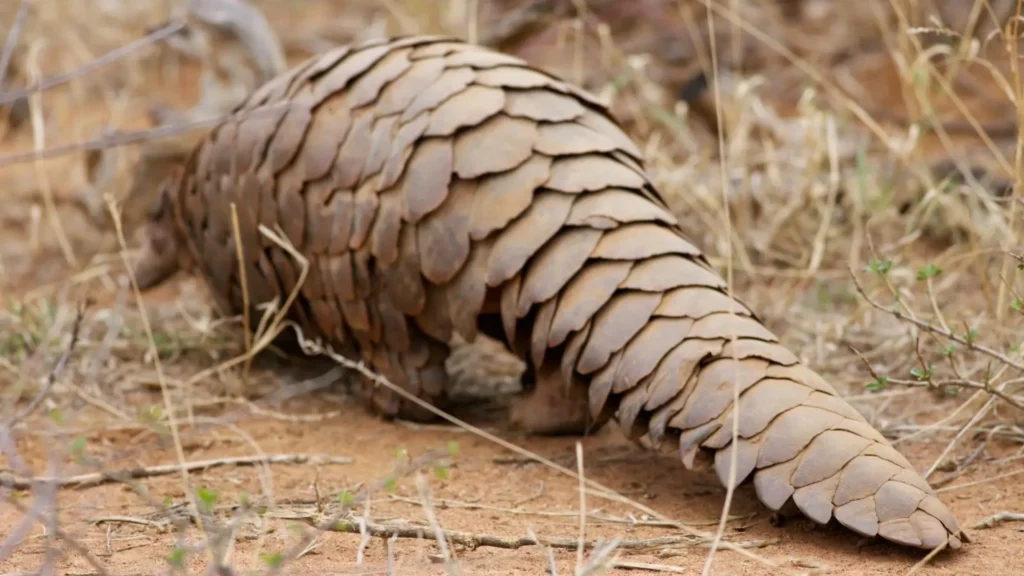
Giant pangolins have a large and smelly anal gland from which they spurt out a malodorous liquid to deter predators!
Only happy when it rains
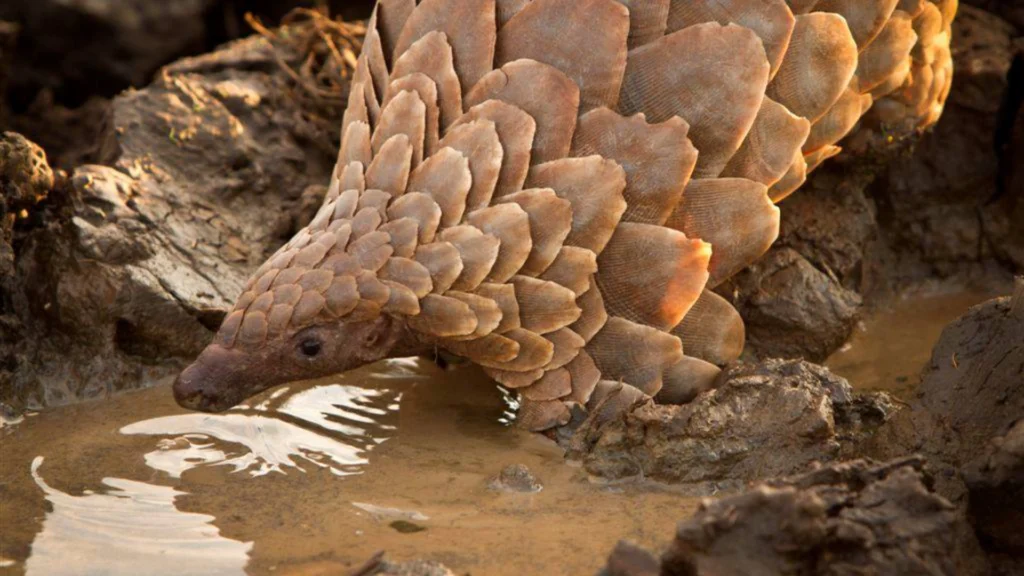
Pangolins live in many different environments but giant pangolins prefer damp, humid environments like the rainforests of west and central Africa and never stray far from water. It was thought that Uganda was the furthest east they lived but a population of giant pangolins has also been discovered in Kenya.8https://www.oxfordmartin.ox.ac.uk/publications/three-spatially-separate-records-confirm-the-presence-of-and-provide-a-range-extension-for-the-giant-pangolin-smutsia-gigantea-in-kenya/ Giant pangolins spend all day hiding in burrows they dig in the ground, or covered in brush and leaves.1https://www.nationalgeographic.com/animals/mammals/facts/giant-pangolin
Threats to the giant pangolin
Pangolins are a critically endangered species and their population is dramatically decreasing – all because of humans.
Trafficking
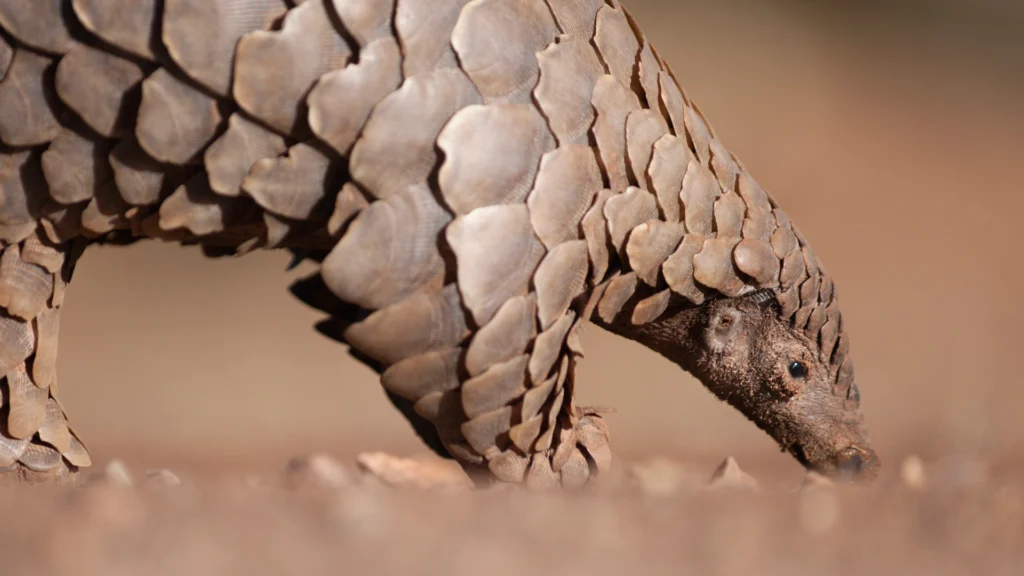
Pangolins are the most-trafficked of all wild mammals in the world9https://ugandacf.org/projects/pangolin-conservation-project/, and this has decimated their numbers. In Uganda, pangolin scales are the second most smuggled wildlife item after ivory. Between 2012 and 2016, over 1,400 pangolins were seized coming out of Uganda10https://www.independent.co.uk/voices/campaigns/giantsclub/pangolin-smuggling-uganda-b1808068.html, and since 2016, there has been a 10-fold increase in the number of pangolins seized by authorities.5https://www.unodc.org/documents/wwcr/2020/Wildlife_crime_Pangolin_UNODC.pdf In 2019, the Uganda Revenue Authority seized 423 kg of pangolin scales worth approximately £1 million.11https://www.monitor.co.ug/uganda/business/prosper/pangolin-nears-extinction-4259752
Pangolins are hunted and killed for their scales, which are used in both traditional African and Chinese medicine, and for their flesh, which is also believed to have medicinal properties, although there is zero scientific evidence to support this. Pangolins are often caught in cruel leg snares, which painfully cut into their skin. In 2021, four people were arrested for trying to smuggle three live pangolins. One of the pangolins was seriously injured from having their leg ensnared but was thankfully able to make a good recovery at Uganda Wildlife Conservation Education Centre.12https://infonile.org/en/2022/05/fighting-poaching-and-the-illegal-trafficking-of-pangolins-in-uganda Most are not so lucky.
In Africa – particularly Nigeria – pangolins are killed for so-called magical and medicinal purposes.7https://www.awf.org/wildlife-conservation/pangolin It is believed that a potion made with pangolin scales can “neutralise witchcraft and evil spirits. If buried near a man’s door they are said to give an interested woman power over him. The smoke from their scales is thought to improve cattle health, keep lions away, and cure ailments like nose-bleeds.”7https://www.awf.org/wildlife-conservation/pangolin Pangolins are also believed to be a bringer of drought and the only way to prevent it is to kill the innocent animal. Of course, none of this is true – pangolin scales are made from keratin like human hair and fingernails, and have no medicinal value whatsoever. It is all a terrible waste of life.
In Asia, the scales are used for Chinese medicine and the pangolin’s flesh is considered a delicacy.7https://www.awf.org/wildlife-conservation/pangolin Previously, Asian countries mainly targeted the Asian species of pangolin but since 2013 the demand has switched to African pangolins, probably due to them having wiped out most of the Asian species.5https://www.unodc.org/documents/wwcr/2020/Wildlife_crime_Pangolin_UNODC.pdf In most cases of illegal trafficking, it is just the pangolin scales that are being trafficked out of Africa and to Asian countries – obviously it is much harder to get away with trafficking a live animal.

Covid-19
Many people had never heard of pangolins before the outbreak of the Covid-19 pandemic at the end of 2019. But when it was suggested that the first cases of Covid-19 originated from a wet market in Wuhan, China, pangolins suddenly became a hot topic. In 2022, scientists confirmed that pangolins, infected with a coronavirus from bats, were probably the source of Covid-19 in humans.13https://www.ncbi.nlm.nih.gov/pmc/articles/PMC9408936/
A pangolin is what’s known as an “intermediate host”. This means that a pangolin can catch and carry viruses – like coronavirus – and pass them on to each other and to humans. As the virus is spread among the host animals, it can mutate and become more contagious. And unhygienic wet markets, where live wild and farmed animals are packed into crowded cages alongside each other, provide the perfect breeding ground for infectious diseases.
Is the pangolin to blame for the Covid-19 pandemic? Absolutely not. It is humans who are to blame for trespassing into the pangolins’ environment, poaching and trafficking the poor animals and imprisoning them in wet markets. We should not need any further proof that if we continue to exploit wild animals it will end badly for everyone – us and them.
Habitat loss
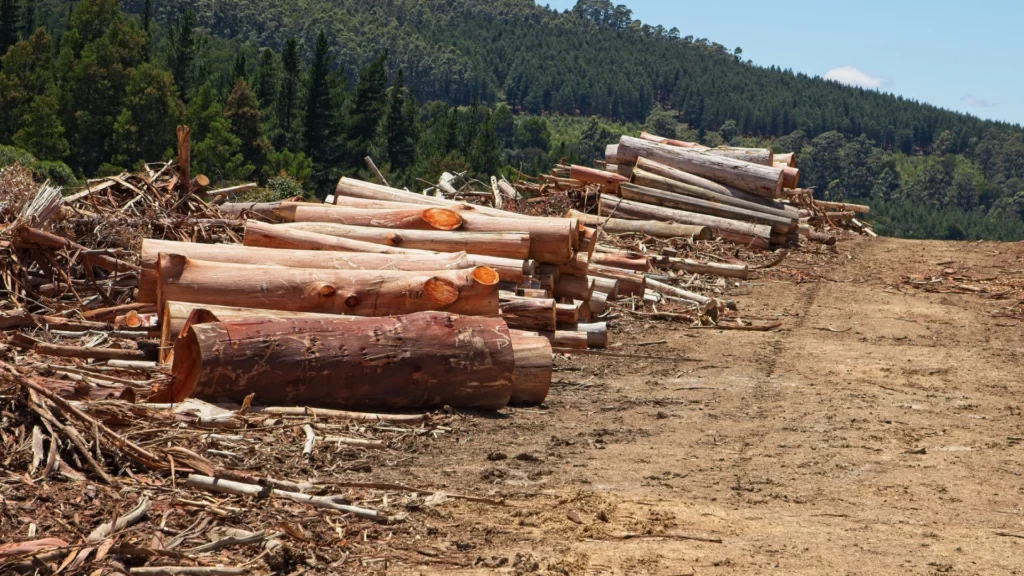
As the human population in Uganda increases, more land is converted into settlements and farmland, and fragmented by roads. Forests are being felled to make way for farms and trees are hacked down for firewood.
The FAO estimates that by 2050, the demand for meat and milk products in Uganda will more than double and “the production of all types of meat and that of milk will increase by 164 and 41 per cent, respectively.”14https://www.fao.org/3/ca7009en/CA7009EN.pdf In order to produce these animal products, land that was once beautiful and iconic savannah and forest – and a home to Uganda’s majestic wildlife – is being turned into farmland.
Bit by bit, the pangolin’s beautiful natural habitat is shrinking and their burrows are being destroyed by the expansion of human infrastructure. As humans spill into the pangolin’s environment, they become increasingly vulnerable to hunting.15https://www.oneearth.org/projects/protecting-habitat-for-four-species-of-endangered-pangolin-in-uganda/
Of course, a growing population needs food but it would be much more sustainable to meet these needs through the growing of crops instead of farming animals. Animal foods require by far the most land and resources – this is because land is not only used for grazing but also for growing food for the animals. The more animal-based foods we eat, the more endangered our forests become. However, crops are a far more efficient way to feed the growing population and use less land and other natural resources. A vegan diet is associated with only half the cropland demand, grazing intensity and overall biomass harvest of meat-based diets16https://www.nature.com/articles/ncomms11382 so switching to a vegan diet would have a phenomenal impact on reducing land degradation and habitat destruction in Uganda.
To make matters worse, huge amounts of oil have been found under Murchison Falls, Uganda’s largest national park and home to the giant pangolin. Despite worldwide opposition by conservationists, French oil company TotalEnergies began drilling in the park in 2023.17https://www.reuters.com/business/energy/frances-totalenergies-starts-commercial-drilling-uganda-project-2023-07-26/ Not only will all the industrial activity disturb and startle the pangolins, but roads created will also make it easier for poachers to access the park.
Giant pangolins require a very specific environment to flourish and do not do well when the landscape is transformed. Pangolins are also near-impossible to keep and breed in captivity so the only way to save the species is to put a halt to deforestation and land conversion in the areas inhabited by pangolins. If efforts are not increased to protect the pangolin’s natural habitat, they will surely become extinct.
References
References
- 1
- 2
- 3
- 4
- 5
- 6
- 7
- 8
- 9
- 10
- 11
- 12
- 13
- 14
- 15
- 16
- 17

